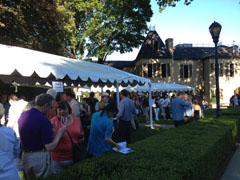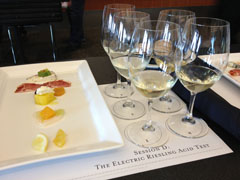Riesling, Riesling, and more Riesling
By Kori ~ July 24th, 2013.
 The fourth Riesling Rendezvous, hosted by Chateau Ste. Michelle of Washington State and Dr. Loosen of Germany, was held last week in Seattle. More than 60 producers from seven countries and seven U.S. states traveled to Washington State to celebrate, explore, and promote Riesling.
The fourth Riesling Rendezvous, hosted by Chateau Ste. Michelle of Washington State and Dr. Loosen of Germany, was held last week in Seattle. More than 60 producers from seven countries and seven U.S. states traveled to Washington State to celebrate, explore, and promote Riesling.
Riesling is one of the most versatile grape varieties. It can be made in many different styles from bone dry to very sweet, reflects the regional character of where it is grown, and is extremely food-friendly. And, it is probably the most age worthy of all white wine varieties. Unfortunately, though, many consumers still mistakenly dismiss it as being cheap and sweet.
As a result of discussions that took place at the first Riesling Rendezvous in 2007, the International Riesling Foundation was formed to help consumers better appreciate the many virtues of Riesling. One of their first orders of business was to develop a system to help consumers know what to expect in a particular bottle of Riesling. The IRF created a Riesling Taste Profile which producers may use on their back labels and other merchandising materials. The winery determines where the arrow should go based on a set of technical guidelines combined with their own judgment from tasting the wine. The Riesling Taste Profile now appears on over 26 million bottles in the U.S. market.

I attended all three days of the Riesling Rendezvous, which included a Grand Tasting, blind tastings, and breakout sessions. Once again, it was wonderful to have so many producers and enthusiasts from all around the world together for a total Riesling immersion. While my eyes were really opened to the ageability of Riesling when I attended the 2010 event, my focus during this year’s Rendezvous was on the food-friendliness of Riesling. Riesling has frequently been a great choice in our challenging wine pairings so it was great to put its food-friendliness under the microscope during some of the tastings and breakout sessions.
“To be a good Riesling, it has to have noticeable acidity. It’s that acidity that makes it work so well with so many foods. Riesling can cut through rich, creamy dishes.†–Paul Lukacs, Wine Writer, Educator, and Advisor
That characteristic acidity as well as the sugar present in the off-dry and sweeter style Rieslings work well with spicy foods. It helps cut the spice and really bring out the flavors.
“Sugar blocks pain receptors in the mouth. That is why off-dry and sweeter wines work so well with spicy dishes.†–Emily Wines MS
 Since I tasted 120+ Rieslings during this three-day Riesling immersion, I’ll spare you a laundry list of all of the wines. However, here are ten wines (listed oldest to youngest) that really grabbed my attention, and I encourage you to give them a try if you have the opportunity.
Since I tasted 120+ Rieslings during this three-day Riesling immersion, I’ll spare you a laundry list of all of the wines. However, here are ten wines (listed oldest to youngest) that really grabbed my attention, and I encourage you to give them a try if you have the opportunity.
1978 Dr. Loosen Erdener Treppchen Riesling Kabinett (Mosel, Germany)
2007 Chateau Ste. Michelle & Dr. Loosen Eroica Single Berry Select (Columbia Valley, Washington)
2008 Tantalus Vineyards Old Vines Riesling (Okanagan Valley, British Columbia, Canada)
2009 Anthony Road Wine Company Martini-Reinhardt Selection Riesling (Finger Lakes, New York)
2011 Donnhoff Niederhauser Hermannshohle Riesling Trocken Grosses Gewachs (Nahe, Germany)
2011 Mission Hill Family Estate Reserve Ice Wine (Okanagan Valley, British Columbia, Canada)
2011 Donnhoff Felsenberg Riesling Grosses Gewachs (Nahe, Germany)
2011 Fritz Haag Brauneberger Juffer Spatlese (Mosel, Germany)
2012 Donnhoff Oberhauser Brucke Riesling Spatlese (Nahe, Germany)
2012 Chateau Ste. Michelle & Dr. Loosen Eroica Gold Riesling (Columbia Valley, Washington)
So whether you are looking for a “deck†wine to enjoy on a warm summer day or are trying to decide what to pair with dinner tonight, think Riesling. Do some experimenting. Look for the IRF Riesling Taste Profile on the bottle and try some different styles to determine what you like best.
Cheers!
Filed under: American Wine, Canadian Wine, Food & Wine, German Wine, New York Wine, Riesling, Washington State Wine, White Wine, Wine Activities/Events

 Wine Peeps is an independent wine blog dedicated to helping you get the most bang for your buck in wine. We do this through blind tastings of wine from around the world and calculations of
Wine Peeps is an independent wine blog dedicated to helping you get the most bang for your buck in wine. We do this through blind tastings of wine from around the world and calculations of 











Kori,
How do the rieslings from B.C. and/or Washington compare to the German or Finger Lakes rieslings? Would love to hear your thoughts. What a great opportunity to taste them all side by side!
I love that Riesling sweetness scale, I just wish it could be more compact. I see a lot of wineries that don’t have space for it on their back labels.
Yashar,
Great point! I, too, would like to see the scale used more often but there’s not a lot of real estate left for it on some labels. Cheers!
Judy,
Great question! My apologies for not replying sooner. Somehow I missed your comment when you posted it. The German Rieslings, in general, are always top quality. I felt like the Washington and BC Rieslings showed very well also. However, at this event at least, I found the Finger Lakes Rieslings to be a bit lacking on the whole. I do feel like that in recent years the differences between Old World and New World Rieslings are lessening. Even the Masters of Wine and Master Somms on the panels had a hard time identifying Old World vs. New World in the blind tastings. It really was a great event and such a wonderful opportunity to taste so many Rieslings from all over the world side by side. Cheers!